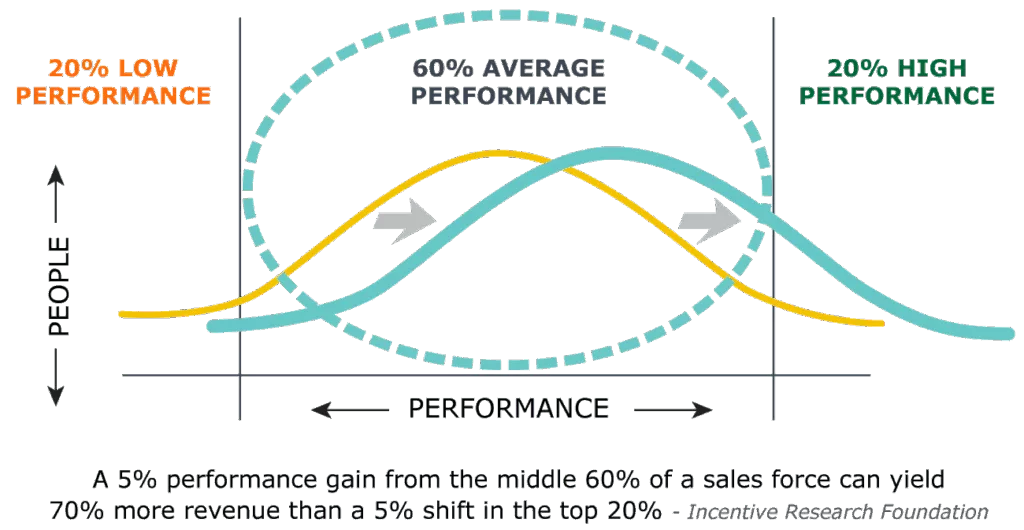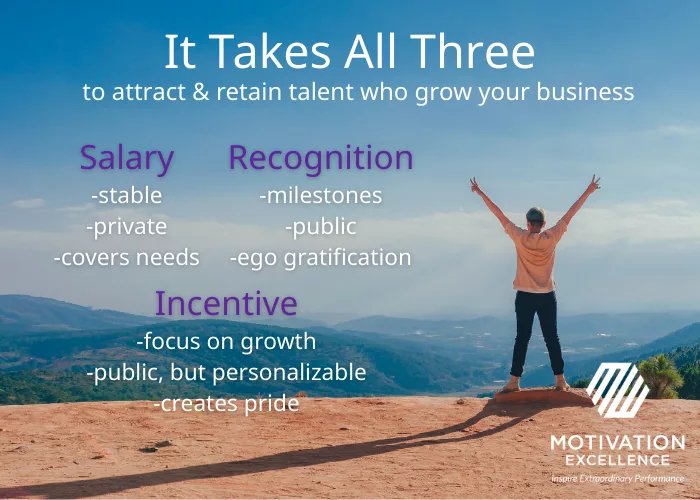
Blog Summary:
· Sales incentives drive measurable performance improvements by motivating your sales team at all levels—especially the middle 60%, which can yield significant revenue increases with even small gains.
· Flexible and well-designed incentive programs align with business goals—everything ranging from short-term boosts to long-term engagement can inspire both individual and team achievements.
· Incentives support sales team member retention and loyalty by adding value to compensation packages, enhancing employee recognition, and fostering a culture of appreciation and motivation.
· When structured correctly, incentives can pay for themselves through incremental revenue gains, compliance, and best practice adoption, especially when rewards are meaningful and tailored to the sales team’s preferences.
Sales Incentives Offer Many Benefits
Getting incentives for outperforming your peers is instilled in us at an early age. Whether it was selling the most Girl Scout cookies for your troop or the most wrapping paper at your elementary school, taking a run at being the top contender definitely could have predestined you to a life in sales as an adult. But, if the reward for being the best wasn’t very good, the motivation to get to the top fell flat too, right?
Running well-designed sales incentive programs at your company can bring in a variety of benefits for both your business and your sales team. You can plan short-term and long-term programs. You can target segments of your sales team to motivate unique behavior changes at different levels.
Rewards for achieving goals can range from exclusive group travel experiences to points that can be redeemed online for almost anything, including individual travel, lifestyle upgrades, trending merchandise, and special event tickets. You can also reward in tiers, so those who bring in more business get rewarded at a level equal to their effort.
Our experts at Motivation Excellence know how to create sales incentive programs that Inspire Extraordinary Performance and can pay for themselves, plus deliver great long-term gains.
Improve Performance
Improving performance is the number one reason our clients run sales incentive programs. Sales incentives have a proven record of boosting performance and can be effectively used to motivate your entire sales force. The Incentive Research Foundation shows how even a small gain from the middle 60% of your team can yield significantly more revenue than the same shift in your top-performing group.

That’s why employing a targeted incentive plan can be a lucrative deal for everyone involved. Your best performers can vie for the top reward, but anyone making improvements gets something. This can encourage healthy competition within your sales team while also motivating achievements on a personal level. When performance gets better, so do the reward opportunities!
Incentives can be very flexible. You can run year-over-year incentives, or schedule them for shorter time periods if it makes sense for your sales cycle. Encouraging sales of a specific item, either because it’s brand new or yields a better margin, can lead to quick gains. The built-in excitement over a limited-time incentive helps drive momentum. Engaging in longer term sales incentives allows team members to plan ahead and perhaps drive in bigger gains. They’re also a great opportunity to track valuable metrics that can be useful for end-of-year review periods.
Whether they’re short- or long-term, sales incentives can keep your team engaged and motivated to perform at a higher level than they did in the period prior.
Retain Talent
There are quite a few things that add to the desirability of working somewhere. Obviously base salary, vacation time, and health insurance are at the top of the list for many! Offering additional benefits like a flexible work environment and education reimbursement can be very appealing as well. Recognizing milestones and special achievements, along with offering incentives for your sales team, helps build a culture where people can see themselves thriving for years.
We advise our clients that retaining top talent, and thus, increasing profits over the long haul, takes three distinct compensation elements: salary, recognition and incentives. They each have a role to play. Combined, they offer stability, acknowledgment, and engagement.

For the recognition and incentive elements, the rewards are key to making these worth the extra effort. They need to have value to your salesperson. If they don’t, they won’t offer anything to an overall benefits package. If they do, you’ve created additional ways to make your team feel valued.
Incentives Can Pay for Themselves
The right rule structure is imperative from the start of any incentive. When we know our clients’ goals, target audience, and some simple sales data, we can build an incentive that pays for itself – and then some – just with incremental gains.
Determining the desired rewards and their cost allows us to back into the performance expectations required to earn them. Selecting motivating rewards, like a group travel experience with company executives to Thailand… or the ability to earn once-in-a-lifetime tickets to a big sporting event… or the option to rent a vacation home for the family, is the lynchpin for the incentive to be successful.
Sales incentives can certainly be a fun, creative, and flexible way to motivate improved performance. This blog focuses on internal sales teams, but everything we’ve written is true for channel partner incentives, too. If you’re interested in reading more about the benefits of channel partner incentives, please check out these recent blogs:
How Incentivizing Channel Partners Helps Your Business Thrive
Channel Partner Engagement: Common Challenges and Overcoming Them
The 4-Step Process for Measuring Channel Incentive ROI
Explore our website and reach out to us if you’d like to consult about how best to run a successful incentive for your company!


